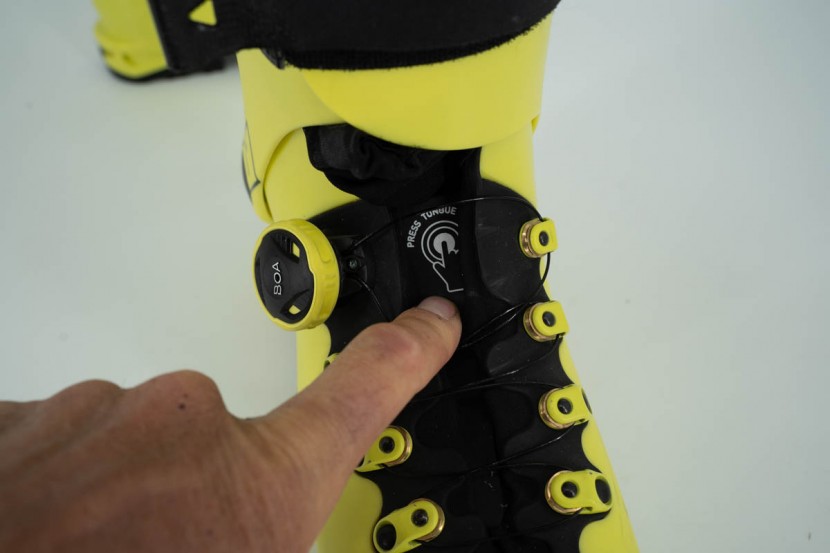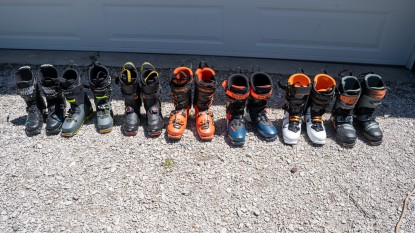Fischer Travers CS Review

Our Verdict
Our Analysis and Test Results
Fischer's entry to the lightweight all-around ski touring boot category is this Travers CS. For various reasons, this boot is proving to be many skiers' first exposure to footwear in this class. And it represents well. It isn't quite as sophisticated in performance as some of the others, but its unique fit, solidly balanced niche, and wide brand loyalty make it a popular and worthy choice for many skiers.
Uphill Performance
For uphill performance, we look at cuff range of motion, cuff friction, and, to a minimal degree, toe pivot location and ergonomics. The Fischer Travers CS has impressive ankle range of motion. Essentially, the cuff will pivot more than your ankles are capable of. This is the new standard for light to mid-weight touring ski boots. If the cuff range limits your range of motion, the boot is decidedly “off the back” now. We like the Travers for this, with one caveat. Most of our testers reported that, during mid to max ankle extension (as when you are kicking that foot and ski forward in a typical skinning stride), the back of the lower shell protrudes into the skier's Achilles tendon area. No one reported any injury from this, but it provided a distracting level of discomfort to all that reported it.
Within that range of motion, we look at cuff friction. Range of motion is important, but you want it to hinge freely with each step. The Travers CS has competitive cuff friction. “Racier” boot options offer lower friction and, therefore, easier ascending. The low-profile stock liner of the Travers helps your cause by reducing the material and stiffness that you need to work against with each step. Of the two major uphill performance criteria (cuff range and cuff friction), cuff range is more limiting on the Travers than cuff friction. This is a little backward from other modern light- to mid-weight ski boots. Most boots we test now have plenty of range but differ in cuff friction. The Travers CS has average cuff friction but has that annoying Achilles impediment in the cuff range. Try these boots on your feet first and make a direct comparison to the others in its class; maybe you will be one of the few that doesn't experience the Achilles pressure in stride.
Weight
Even here in the “Imperial USA”, Backcountry ski gear is increasingly being reported and compared in metric units. We can tell you that the Fischer Travers CS weighs four pounds seven ounces for the pair. That's how GearLab's weight convention works; we report weight in pounds and ounces for the entire product.
However, the rest of the internet backcountry ski gear community is reporting product weights in grams/kilograms and doing so for just one leg/foot worth of gear. If you wish to compare our information to info from manufacturers, retailers, and other reviewers, you'll want to use metric units and look at each piece of gear individually. In that way, on our scale and for size 26.5, the Travers CS weighs 1012g per boot. This “one-kilo” class is increasingly crowded, in a great way. We are finding that this weight range provides all-around function for all-season and all-mountain human-powered skiing. Some of our favorite boots to backcountry ski in are in this weight range, within tens of grams.
Further, there are multiple parts to a ski boot that you need to weigh. You might wish, for instance, to ditch the stock liner of whatever ski boot you choose and add your preferred aftermarket option (this isn't entirely necessary with the Travers CS. We liked the stock “Palau” brand liner that is included). In any case, if you are shopping by weight and wish to replace the liner regardless, learn to compare boots by their shell weight. One shell of the Fischer Travers CS (again, in size 26.5) weighs 870 grams.
Downhill Performance
You select a lightweight boot like the Fischer Travers CS for compromised uphill and downhill performance. This shoe skis great. For such a lightweight product. Align your expectations before going any further. You won't have the support and control in any lightweight boot like you will in any boot that is 3-400 grams heavier. The best touring boots now weigh just 200 grams more and ski considerably better than this Fischer. Those heavier boots ski better because of the weight and because of design matters that inherently increase ski performance and decrease cuff range/mobility. Again, you make real and irreducible compromises to downhill control, speed, performance, and support by choosing a lighter, better-touring boot over a beefier version.
Let's hone our comparison in a little bit. Let's confine our analysis now to just those boots that weigh and tour about the same as the Fischer Travers CS. In this class, the Travers is above average. Of the dozen or so boots in this weight category that we have tested, the Travers CS is better than most. The forward flex action is progressive and smooth, all things considered. Your heel is held down better than we expect from the minimalist boa/strap closure. Lateral and rearward support competes with carbon cuff options, but the CS only has carbon in the sole. In fact, the distribution of carbon in the CS, we think, makes it feel both simple and sophisticated. Carbon in the cuff would indeed lend stiffness but would compromise forward flex progression. Maybe carbon cuffs are a thing of the past? A few direct competitors, though, definitely ski better. The cuff of the Travers CS feels low, for one thing. A direct comparison to other boots in the class indicates that it isn't actually appreciably lower, but it felt that way to a number of our testers.
Comfort and Fit
The Fischer Travers CS is a relatively high-volume shoe. The heel pocket holds well enough on average sized lower ankles while the toe pocket and forefoot are wider than normal. For the size, the Travers CS is shorter than normal. Our lead tester has worn more than 30 different size 26.5 touring ski boots. The only boot in which his toe touches the front is the Travers CS. The shorter format is still roomy in volume and width. It makes for a pretty specialized fit. You can get a little more toe space with a pro bootfitter, but you won't be able to fill in the width/volume. Average to wide-footed people are the only ones that should be considering the Travers CS.
Warmth
Warmth is primarily a matter of fit. See above for how the Travers CS fits. Fit too close, and the most insulating boot will leave you with cold feet. Let the circulation flow, and your feet will do better, almost regardless of materials/insulation. After fit, warmth is driven by the amount of material in the shell and liner. Liner material is more insulating than shell material. Lightweight shells, upsized with thicker liners, will be warmer than heavy shells and thinner liners. All that is a bit moot with the lightest boots like the Fischer Travers CS. To get this boot as light as possible, liner and shell material are thinned to the max. These aren't warm boots, but neither are any other boots like them. You can stay comfortable in cold conditions by moving continuously and keeping yourself overall healthy and insulated. Don't count on any lightweight boots like the Fischer Travers CS, overcoming circulation difficulties or sloppy self-care in cold conditions.
Ease of Use
What does it take to get in and out of the boots? What about compatibility with bindings and crampons? Are the boots' transitions between uphill and downhill smooth and doable with gloves on in tough conditions? In short, we like the ease of use of the Fischer Travers CS. The BOA brand closure on the lower cuff grabs securely and spreads the tension evenly. The inner “tongue” gusset is a little unique in that it needs to be pressed in to nest all the folds correctly. Other boots don't have this going on. The upper “buckle” is actually a huge velcro strap with final tightening provided by a long-throw cam buckle. Set up the velcro portion at the beginning of the day, and transitions can be done with just the buckle throw. The rear-mounted, flip-actuated ski/walk mode works cleanly and reliably. Only in the iciest of near-freezing temps will it ice up on you. In that case, it doesn't take much to knock it clear.
We had no problems with tech binding or crampon compatibility. Don't try and use these boots in non-tech AT or Alpine ski bindings; they aren't made for that. Other reviews online report issues with crampon compatibility. We had no such problems with the Fischer Travers CS. Incidentally, we've never had such problems with any ski boots we have tested. This suggests that at least part of the issue is user error. Crank your crampons tight enough, and many so-called “compatibility issues” evaporate. This is perhaps a case where brute force is the warranted solution.
Value
The cost of the Fischer Travers CS is competitive with similar options on the market. It is certainly not cheap, but it isn't head and shoulders above the rest. Value, though, is more than initial purchase price. We argue that these are a good value. First, the liners are better than average. It is less likely that you will need to replace these than with most of the closest competitors. Next, the simple construction has held up well for us and for other testers. The BOA system is a tiny bit unnerving, but we've put in tons of hours on similar systems in other contexts with minimal issues. Fischer mounts theirs on the outside, which makes it a little more vulnerable but allows you to monitor potential damage. Other than the BOA, there are no weird strings or cables to wear out.
Conclusion
We recommend these boots if they fit and if you aren't adversely affected by the rear shell touring interference some of us experienced. They strike an excellent balance of touring to ski performance. They have a unique fit that won't work for everyone but will work well for those that can't make anything else work.
| Awards | |
|---|---|
| Price | $850 List |
Overall Score  |
|
| Star Rating | |
| Bottom Line | A great lightweight touring boot that gives those with particular foot shapes an alternative |
| Pros | Light, simple, balanced performance |
| Cons | Wide, short fit; likely rear shell discomfort in touring mode |
| Rating Categories | Fischer Travers CS |
| Downhill Performance (35%) | |
| Uphill Performance (20%) | |
| Weight (20%) | |
| Comfort and Fit (10%) | |
| Warmth (10%) | |
| Ease of Use (5%) | |
| Specifications | Fischer Travers CS |
| Weight per Pair (Size 26.5) | 4 lbs 7 oz |
| Binding Compatibility? | Tech only |
| Measured Range of Motion (degrees) | 79° |
| Manufacturer Stated Last Width | 106 mm |
| Weight of One Complete Boot, No Insole | 1012 g |
| Weight of One Boot Shell | 870 g |
| Weight of One Stock Liner, No Footbed | 142 g |
| Stated Flex Index | Not Listed |
| Liner Design | Tongue |
| Shell Material | Grilamid |











